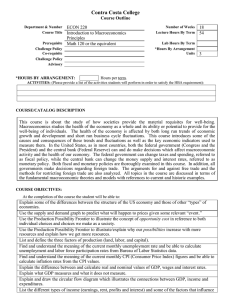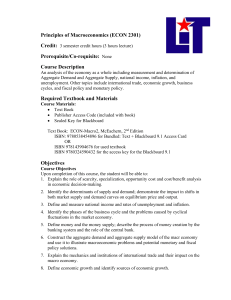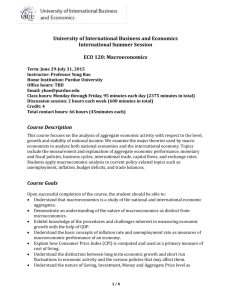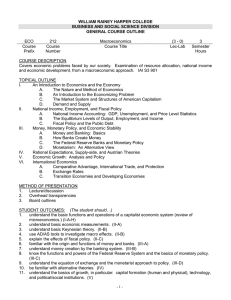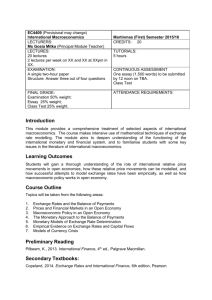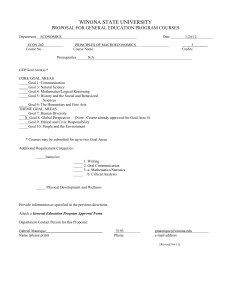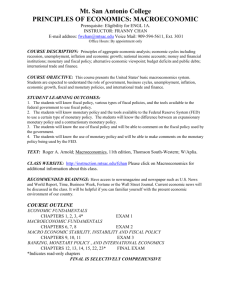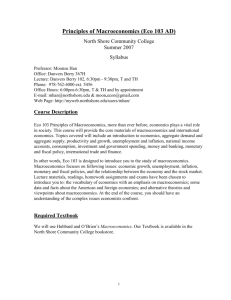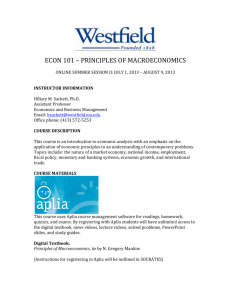Syllabus - Patriotech Learning
advertisement
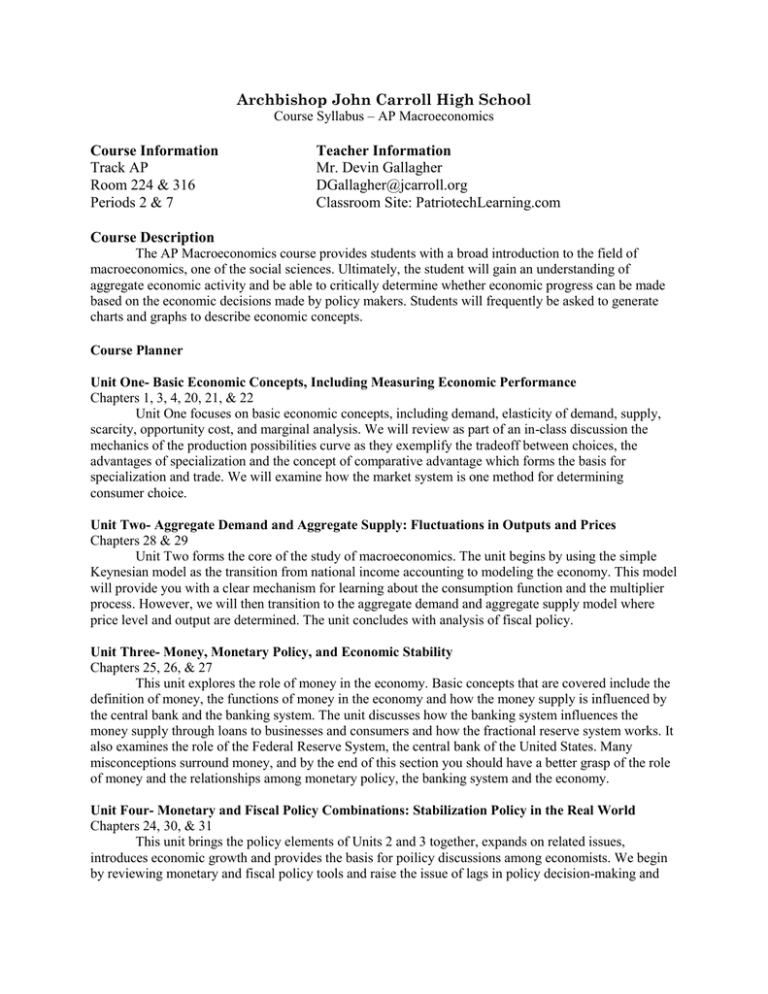
Archbishop John Carroll High School Course Syllabus – AP Macroeconomics Course Information Track AP Room 224 & 316 Periods 2 & 7 Teacher Information Mr. Devin Gallagher DGallagher@jcarroll.org Classroom Site: PatriotechLearning.com Course Description The AP Macroeconomics course provides students with a broad introduction to the field of macroeconomics, one of the social sciences. Ultimately, the student will gain an understanding of aggregate economic activity and be able to critically determine whether economic progress can be made based on the economic decisions made by policy makers. Students will frequently be asked to generate charts and graphs to describe economic concepts. Course Planner Unit One- Basic Economic Concepts, Including Measuring Economic Performance Chapters 1, 3, 4, 20, 21, & 22 Unit One focuses on basic economic concepts, including demand, elasticity of demand, supply, scarcity, opportunity cost, and marginal analysis. We will review as part of an in-class discussion the mechanics of the production possibilities curve as they exemplify the tradeoff between choices, the advantages of specialization and the concept of comparative advantage which forms the basis for specialization and trade. We will examine how the market system is one method for determining consumer choice. Unit Two- Aggregate Demand and Aggregate Supply: Fluctuations in Outputs and Prices Chapters 28 & 29 Unit Two forms the core of the study of macroeconomics. The unit begins by using the simple Keynesian model as the transition from national income accounting to modeling the economy. This model will provide you with a clear mechanism for learning about the consumption function and the multiplier process. However, we will then transition to the aggregate demand and aggregate supply model where price level and output are determined. The unit concludes with analysis of fiscal policy. Unit Three- Money, Monetary Policy, and Economic Stability Chapters 25, 26, & 27 This unit explores the role of money in the economy. Basic concepts that are covered include the definition of money, the functions of money in the economy and how the money supply is influenced by the central bank and the banking system. The unit discusses how the banking system influences the money supply through loans to businesses and consumers and how the fractional reserve system works. It also examines the role of the Federal Reserve System, the central bank of the United States. Many misconceptions surround money, and by the end of this section you should have a better grasp of the role of money and the relationships among monetary policy, the banking system and the economy. Unit Four- Monetary and Fiscal Policy Combinations: Stabilization Policy in the Real World Chapters 24, 30, & 31 This unit brings the policy elements of Units 2 and 3 together, expands on related issues, introduces economic growth and provides the basis for poilicy discussions among economists. We begin by reviewing monetary and fiscal policy tools and raise the issue of lags in policy decision-making and implementation in the economy. This includes a discussion of crowding-out, a primary argument used by some economists to dismiss the positive effects of fiscal policy. Unit Five- International Economics Chapter 33 In this unit we will introduce the international sector into the closed economy discussed in Units 1 through 4. We will review the concepts of comparative advantage and production possibilities. We will analyze the effects of government intervention in international trade and examine the basic components of international finance, including balance of payments accounts and foreign exchange markets. We will investigate two types of policies: trade policies and domestic stabilization policies, especially combined with the influence of domestic monetary and fiscal policies. Student Evaluation Tests & Quizzes Project Homework & Assignments In-Class Participation & Exercises 50% 20% 20% 10% One large project will be given each quarter. All other presentations, papers, and homework will contribute to the Homework & Assignments portion of a student's grade. A student may only be eligible for an extra credit assignment if their daily participation average is 3 or better. Daily Participation Grades will be recorded as follows: 4- Asked on-topic questions leading class into engaging discussions; frequently volunteered 3- Volunteered in class at least once 2- Remained unengaged throughout class 1- Was doing non-class related activities (playing on phone, sleeping, being disruptive) Classroom Requirements As this is an AP course, students will be treated in a way that will prepare them for college. This may include but is not limited to being expected to remember due dates without being reminded daily, obtaining notes or assignments from a peer when absent, and students taking the initiative themselves to come to me for external help in class. Being absent may not be an excuse for handing in an assignment late. Students may submit any assignments electronically via email if absent by 4:00 p.m. to not be considered late. Makeup tests and quizzes must be taken within one week of original test date before or after school hours. Makeup assessments may vary from the original given in class as to deter academic dishonesty. It is the burden of the student to make arrangements for the makeup test before the deadline. Failure to reschedule in time may result in a failing grade for the assessment. Use of personal electronic devices such as tablets and smart phones will be permitted for note taking and other class-focused uses. Using devices for non-class related activities may directly affect a student's participation grade. Please check and sign below ______________I have read the information and I fully understand what I’m expected to do in class. Student Signature: ____________________________________ Parent / Guardian Signature: ___________________________________



